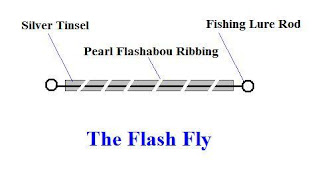Background:
The upper sections of Lewiston Lake look and act like a river due to the flows coming all summer from Trinity Lake. During the hot parts of the day, many pontoon boats (houseboats without the houses) motor to the top of the lake and drift down, using bait with a Seps Flasher just above the bait. I have seen dozens of trout caught this way each day, usually on days when the flyfishing isn’t great (Duh, the fish are at the bottom of the 10 foot deep runs, in cold water, between rocks lol). The common perception is that the flashers significantly increase the catch rate for the fishermen.
The upper sections of Lewiston Lake look ideal for the use of drifting methods used on the Lower Sacramento River: Floating Line; Large indicator; 12 feet of leader after the indicator; two flies appropriate for the insect life in the water, and weight to get the flies down (I’ve never done this – just found info on the net lol).
The Question:
Will the use of a “flasher fly” increase the hookup rate during drifting using the Lower Sacramento River technique? (I’m using hook-up rate because I never seem to get the hooked fish into the net. That’s okay because I’ve been told that long line releases are better for the fish!!!!
The Flash Fly
I want something that can be put into the leader while still allowing for a cast, even though info on the net calls the cast a “chuck and duck” experience into the water away from the boat. I’ve decided to make an attractor fly (THE “Flash Fly”) using: A metal rod designed to allow people to build their own lures, silver tinsel, and pearl flashabou. The materials are in the mail and I’ll tie up a dozen Flash Flies as soon as they arrive.

The Experiment Outline
To answer the question above, after converting it to the appropriate null hypothesis, I’m going to set up two identical rods, one with the Flash Fly and one without out the Flash Fly. I’ll make drifts through the same section of water throughout the spring and summer, noting weather, flow rate, catch rate, etc. The choice of rod (Flash Fly or No Flash Fly) will be randomly assigned. I plan to use the Student’s t-test to compare the #drifts to the #hook-ups to see if there is a statistical difference between the two setups. I hope to get enough drifts this summer to average out the effects due to weather and flow rate.

The Expected Persecution
Flyfishermen and Flyfisherwomen will undoubtedly see using a flasher as “breaking the rules” of flyfishing (although you can read countless recommendations of using an attractor fly above a dropper fly). Some people become angry / weird / scary when they see someone “breaking the rules”. About 10 years ago I was talking to a worker in a West Yellowstone fly shop, describing how I caught two Yellowstone cutthroat trout using a dry fly with a parachute cast downstream. He stated that he was surprised that I wasn’t yelled at. Evidently, at the Lewiston River outside of Yellowstone, fishermen were yelling at each other because it was accepted that fishing a dry fly downstream was unsporting. I doubt they would accept The Flash Fly.
More about the experimental design in Part 2.
No comments:
Post a Comment